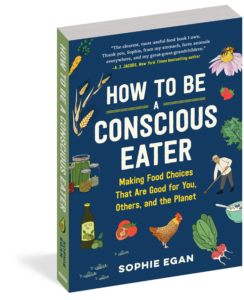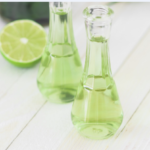Learn how to read egg labels to get the best produce.
In her book, How to Be a Conscious Eater, Sophie Egan explains how to buy food that’s good for you, for others, and for the planet. Knowing the real meaning behind egg labels is an easy way to answer “yes!” to these three questions when it comes to grabbing your next carton of eggs off the shelf at the grocery store.
Excerpted from How to Be a Conscious Eater by Sophie Egan. Copyright © 2020.
THE LAUNDRY LIST OF EGG LABELS
Frankly, people do judge a book by its cover. In the grocery store, you’ll see egg cartons swaddled in so many labels, they might remind you of vintage suitcases stamped with alluring stickers of destinations visited. An egg carton may feature depictions of bright rays of sunshine, cherry-red barns, or cartoon images of deliriously happy hens. On price, you see a significant spectrum. The labels range from meaningless to meaningful, with some gray area in between.
THE FOLLOWING LABELS ARE MEANINGLESS—NOTHING BUT MARKETING:
“Natural” // “All-Natural” // “Fresh” // “Farm-Fresh”
“No Hormones.” This goes without saying in the egg industry. Hens that lay eggs aren’t allowed to be given hormones. All eggs are no-hormone eggs.
“United Egg Producers Certified.” This voluntary program looks impressive on a label but acts as the least common denominator for egg producers, nearly all of whom participate. Its standards are technically verified, but those standards are so low, I wouldn’t put any stock in the label: Hens are still confined, jam-packed with other hens, and deprived of fresh air and sunlight.
THESE LABELS ARE MEANINGFUL; THE PRACTICES HAVE BEEN VETTED AND ARE WORTH YOUR ATTENTION:
“Certified Humane Raised and Handled.” This certification ensures that specic standards have been met for one of the three levels related to eggs—cage-free, free-range, or pasture-raised. If you see this label, you’ll also see one of those three designations.
“Global Animal Partnership (GAP) Certified.” This is a five-step program tailored to specific species, including egg-laying hens, and is most notably used by Whole Foods Market. Look for these different steps, which have different label colors: Step 1: no cages, crates, or crowding; Step 2: enriched environments (supplying materials—like hay bales and food hung from a string—that encourage their natural behaviors, such as scratching, foraging, pecking, and exploring); Step 3: enhanced outdoor access; Step 4: pasture-centered; Step 5: animal-centered and no physical alterations. Step 5+ means animal-centered and their entire lives are spent on the same farm (except for chickens, which may be transferred right before slaughter). It also means no growth hormones, animal by-products in any species’ feed, or antibiotics (except for chickens). This is the highest rating available.
“No Antibiotics.” This means egg producers did not add antibiotics to the feed or water of the egg-laying chickens.
“Certified Organic.” Carefully regulated by the USDA, organic certification sets specic requirements for what egg-laying hens are fed—the food must be vegetarian and free from pesticides or antibiotics—and how the land they’re raised on is treated. So, it’s a strong one from environmental and public health standpoints. Where it’s not so strong is animal welfare. For assurance of access to the outdoors or more extensive lifestyle enhancements for the birds, look for the aforementioned animal welfare labels or the more rigorous versions of “pasture-raised” or “free-range,” as described below.
THESE LABELS REPRESENT THE VAST GRAY AREA IN BETWEEN MEANINGLESS AND MEANINGFUL—NOT BAD, BUT THE INTENTION- TO-REALITY RATIO IS MURKY:
“Cage-Free.” Hens are likely still raised in very confined quarters squished up against each other, and they may or may not be let outdoors. But at least they’re not in tiny cages, and in theory they are free to move around and do their usual chicken thing. Cage-free means a lot more when buying eggs—whose hens are indeed most commonly conned to cruelly small cages— than it does when buying chicken, because broilers aren’t usually raised in cages to begin with.
“Free-Range” or “Free-Roaming.” This one is often interchangeable with “cage-free,” except its extra selling point is outdoor access. The problem is that there’s no regulatory definition of free-range, so in practice the outdoor space could be quite small, and that access might be available to only a fraction of the hens in a given house. It’s best if it’s attached to a third-party verication for animal welfare standards.
“Pasture-Raised.” A fairly good indicator, the term means birds were mostly raised outside and let loose to roam and forage for food. Consider it a notch above free-range and cage-free. That said, it’s not enforced by the USDA, so the exact meaning is rather hazy. Your best bet is to trust this claim when it is paired with one of the legit animal welfare labels like “Certied Humane Raised and Handled.”
“Vegetarian-Fed.” This is fairly straightforward, but the reason it’s noteworthy is that a lot of agribusiness involves feeding food animals parts of other animals. Although this issue isn’t as relevant in the egg industry as it is in meat and poultry, it can be a reassurance for some shoppers, and especially vegetarian shoppers.
“Omega-3s.” This label means the hens’ feed included one of the main sources of omega-3 fatty acids—most commonly fish oil, flaxseeds, or flaxseed oil. Although you can indeed add to your daily omega-3 tally this way, the challenge is knowing which type of omega-3 and how much you’re getting, since the conversion to human nutrient is unclear on the packaging and not required on the label. These eggs are probably perfectly fine to eat, but can sometimes be a waste of the extra money. You might focus your omega-hunting attentions elsewhere in your diet, such as by eating fish or flaxseed directly.
Finally, pay attention to what the egg carton is made of. Buy eggs whose containers are cardboard, ideally, which is compostable. Second choice is plastic, which is at least recyclable. Never buy eggs in Styrofoam. That material is all-around bad and should be eliminated from use wherever it still manages to turn up.
More About How to Be a Conscious Eater
 A radically practical guide to making food choices that are are good for you, others, and the planet.
A radically practical guide to making food choices that are are good for you, others, and the planet.
Is organic really worth it? Are eggs ok to eat? If so, which ones are best for you, and for the chicken—Cage-Free, Free-Range, Pasture-Raised? What about farmed salmon, soy milk, sugar, gluten, fermented foods, coconut oil, almonds? Thumbs-up, thumbs-down, or somewhere in between?
Using three criteria—Is it good for me? Is it good for others? Is it good for the planet?—Sophie Egan helps us navigate the bewildering world of food so that we can all become conscious eaters. To eat consciously is not about diets, fads, or hard-and-fast rules. It’s about having straightforward, accurate information to make smart, thoughtful choices amid the chaos of conflicting news and marketing hype. An expert on food’s impact on human and environmental health, Egan organizes the book into four categories—stuff that comes from the ground, stuff that comes from animals, stuff that comes from factories, and stuff that’s made in restaurant kitchens. This practical guide offers bottom-line answers to your most top-of-mind questions about what to eat.
Buy the Book
Amazon | B&N | Indiebound | Workman





1 Comment
DONNA FRATEPIETRO
March 26, 2020 at 2:04 pmIf you buy eggs and the expiration date is a week away, can you eat them after the date, and if you can how long will they be good?